

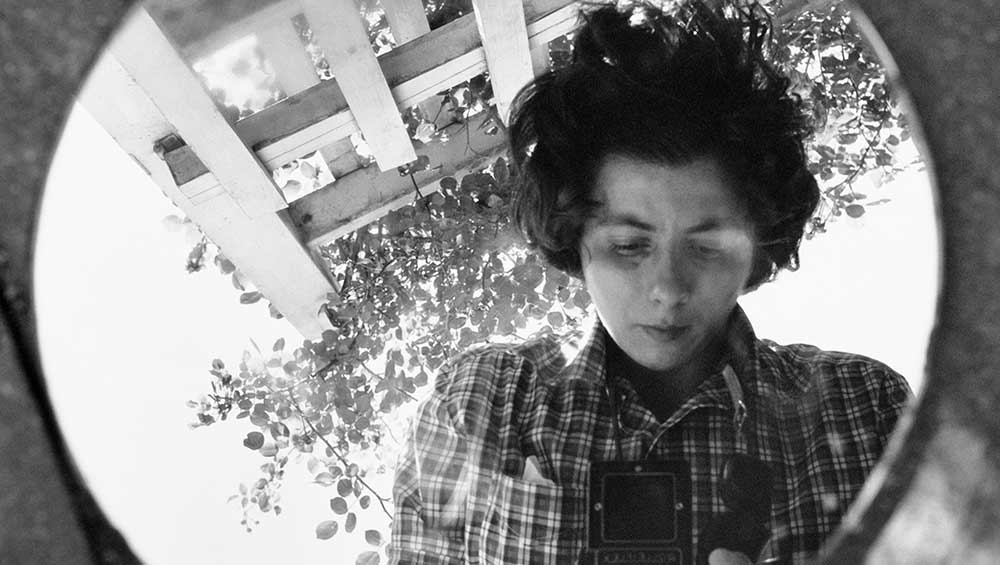
Vivian Maier, Self-portrait, New York, 1953 (detail). © Estate of Vivian Maier, Courtesy of Maloof Collection and Howard Greenberg Gallery, NY.
MK Gallery, Milton Keynes
11 June – 25 September 2022
by VERONICA SIMPSON
The art world and its collectors love nothing better than an old, previously undiscovered artist – except, perhaps, a dead one with an enormous back catalogue.
A young local historian and writer called John Maloof hit the jackpot when he unearthed the work of Vivian Maier (1926-2009) – a gifted, amateur photographer whose photos of the streets and citizens of Chicago could end up defining a certain period in that city, just as Henri Cartier-Bresson’s or Robert Doisneau’s do for Paris or Diane Arbus’s and Helen Levitt’s for New York.
In 2007, while researching images for a book on Chicago’s Northwest Side, Maloof came across a trunk of Maier’s photos at an auction. He was looking for black-and-white photos of Chicago in the 1960s. But when he got the trunk home, he was struck by the quality of the images, and became increasingly curious about their author.
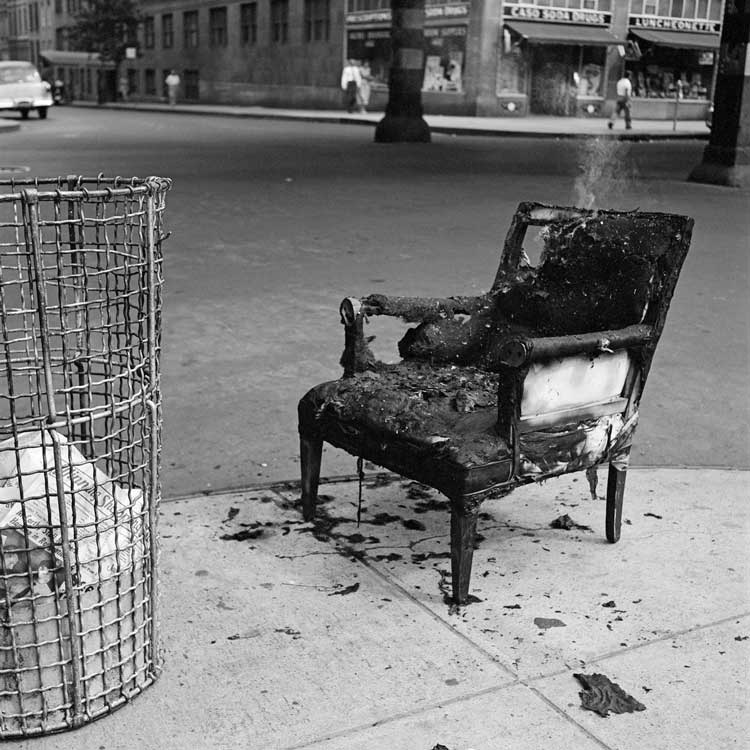
Vivian Maier, New York, 1954.
© Estate of Vivian Maier, Courtesy of Maloof Collection and Howard Greenberg Gallery, NY.
He began to look for more, and found them. Several more trunks came to light – they were being sold off in 2007 by the storage depot where Maier had kept them, in lieu of payment. The rich repertoire of images he found triggered Maloof’s journey to making a documentary that became Finding Vivian Maier, which has won numerous awards since its release in 2014. He discovered that she had mostly made her living as a nanny. For 40 years, she received minimal wages (having to live-in, for most of her life) looking after the children of Chicago’s affluent middle classes and, occasionally, those of musicians and TV stars. It was a job she seemed to relish initially. But she never stopped taking pictures.
It seems she couldn’t help herself. According to the various former charges of hers interviewed for the documentary, the camera would accompany them on every outing. One woman recalls being taken to some pretty unsavoury parts of town so that Maier could capture lives marked by poverty and neglect.
She was not deterred by lack of recognition or interest; she knew she was good. One of the intriguing aspects of her story is the fabrications she told people, one of which was that she was French. In fact, her mother was French and her father was Austro-Hungarian, though he left them when she was four. However, she was born in New York. She did spend time in Europe and in her youth ventured to the part of France from which her mother’s family came. Here, she made friends with a local photographer and printer, and they even discussed mounting an exhibition of her work. But it came to nothing. The world, it seems, wasn’t interested in her perspective – whether that was thanks to the prevailing postwar misogyny, art world chauvinism, or Maier’s lack of persistence, ambition or connections.
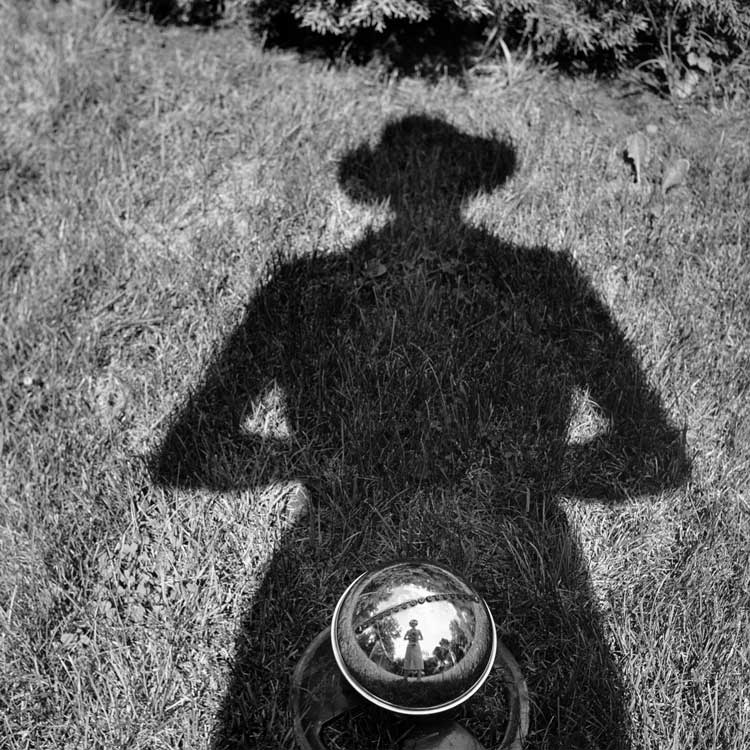
Vivian Maier, Self-Portrait, not dated. © Estate of Vivian Maier, Courtesy of Maloof Collection and Howard Greenberg Gallery, NY.
She bought good cameras, however, and shot prolifically, but rarely printed her work – perhaps because of lack of funds, or possibly out of consideration or concern for her subjects. As one wall text asks: “Did the people she photographed consent or even know they were being photographed? Should we be showing work she kept private?”
There are more than 140 of her images here, mostly black-and-white but a few in colour, plus some film and audio. They are a tiny representation of the extraordinary range and scope of her interests, but they substantiate what the critic Allan Sekula said of Maier’s photos, that they tell a more “open and inclusive and very fundamental idea of what constituted ‘America’ that was missed by a lot of photographers in the 1950s and 60s.” The prevailing qualities are curiosity and compassion for everyday people and their lives. Maier had not just an eye, but also a knack of relating to her subjects. Carrying her Rolleiflex camera, which is held at waist height, meant that she could look her subjects in the eye, frankly and calmly. It feels as if she “saw” these people. That sense of being seen is present in so many of the portraits and snapshots here, in her subjects’ relaxed poses, their calm absorption in the moment. At a time before relentless media intrusion, social media or reality TV, who would have reason to suspect or be wary of an ordinary-looking woman with a camera? People had not learned how to posture or preen or worry about their image. Her subjects clearly felt comfortable in her presence.
The show majors on her assorted self-portraits, in all their variety. These are modest, inquiring, either capturing her reflections in glass or in shadow. Three such portraits kick off the curatorial narrative, all from New York in 1953 - one playful shot in a circular mirror fringed with trees, another of a youthful Maier with her even more youthful charge appraising themselves in a shop window.
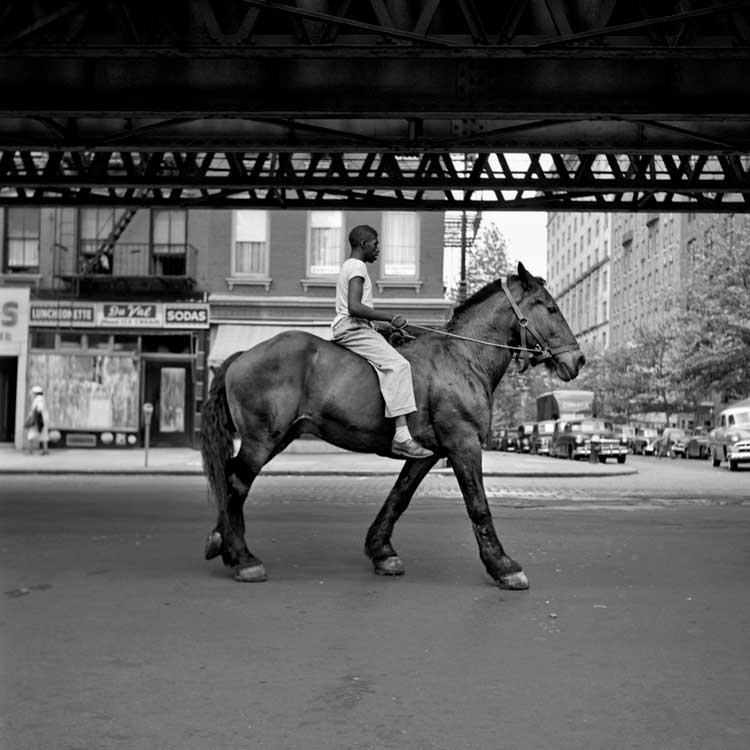
Vivian Maier, New York, 1953.
© Estate of Vivian Maier, Courtesy of Maloof Collection and Howard Greenberg Gallery, NY.
The rest of this first room features more photos from New York: a couple holding hands at a restaurant table, snapped from above; two older men bending over a hose, its rubbery, snake-like coils stark against a wet New York pavement. She has such a talent for spotting the atmospheric moment. Here, we have a father walking hand in hand with two children down a rain-soaked, wintry pavement, silhouetted in a moment of sunshine. There, an old lady glancing up as Maier snaps her lurking in the wreckage of a collapsed building – perhaps a former home? One senses the untold stories behind these characters. Maier’s images offer that filmic sense of providing a portal into their rich and complex lives. They are caught mid-moment, free from artifice - apart from a memorable shot of two grubby street urchins in front of a poster for the film Striporama (“in Gorgeous Color”). The boy is performing a handstand, the girl is ignoring Maier and calmly inspecting a rag, but is all the more remarkable for her clothing: a sumptuously patterned frock, a man’s lumberjack shirt and just one shoe. You could build a short story around this duo.
Maier is good not just at seeing people but creating connections with place. There is a fantastic composition of two tiny people standing by a road, clearly shot from on top of some huge bridge, but with just one vertical, structural support extending down into the frame, like the black leg and white paw of a huge metal dog.
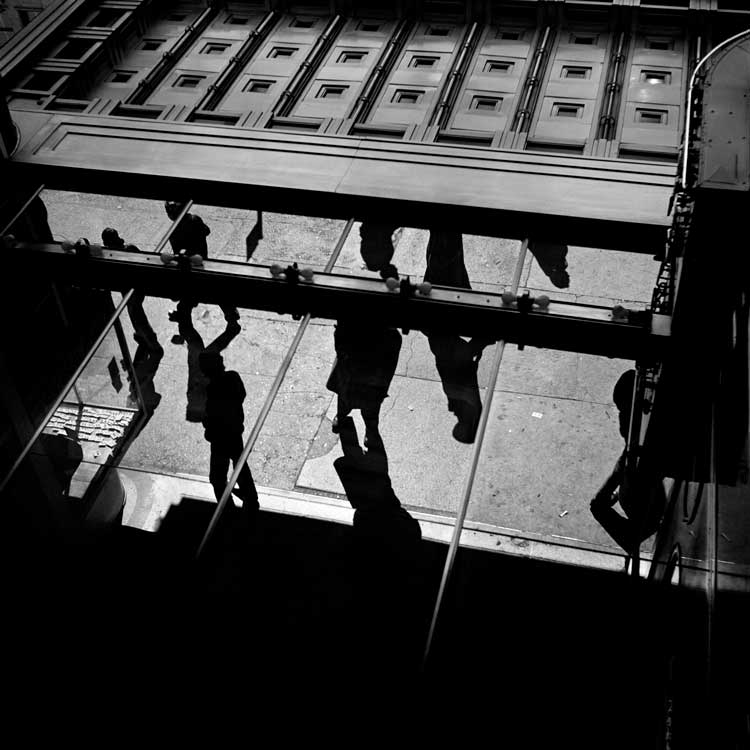
Vivian Maier, New York, 1954.
© Estate of Vivian Maier, Courtesy of Maloof Collection and Howard Greenberg Gallery, NY.
She has a knack for playful or surreal tableaux, strange juxtapositions of the kind that nowadays go viral on social media, such as the closeup of a policeman’s back, with his hands held behind his waist holding what appear to be two mopheads. She would have been a phenomenon on Instagram.
Another black-and-white gem shows a tower of newspapers, all folded at the point where the words hahahahaha appear. On closer inspection that persistent laugh is a speech bubble emerging from the mouth of Charles Schulz’s Snoopy character, from the famous Peanuts cartoon. She captures cities mid-construction and deconstruction, such as one of a new Chicago skyscraper emerging from the inverted “V” of a partially demolished building in Streeterville.
One marvels at the speed and skill with which she frames moments of significance, never going for the obvious narrative. A well-dressed young black man in suit and hat, with his pit bull, is leaning, nonchalantly against a window, holding a tin cup into which a suited but hatless older white man is dropping a dime. Who has more style and more intrigue? Not the latter.
She clearly feels herself a woman of the people, albeit one whose dispassionate gaze is informed by her outsider status. Her wealthy clients could whisk her around the glamour spots of America and beyond, but she never forgot that everyman/woman vantage point. I like her attunement to the ridiculous aspects of her aspirational, consumerist age – as evidenced by the exotic, chrome-clad rear end of a state-of-the-art sports car parked in a suburban garage, with two cats taking shelter under it from the day’s heat.
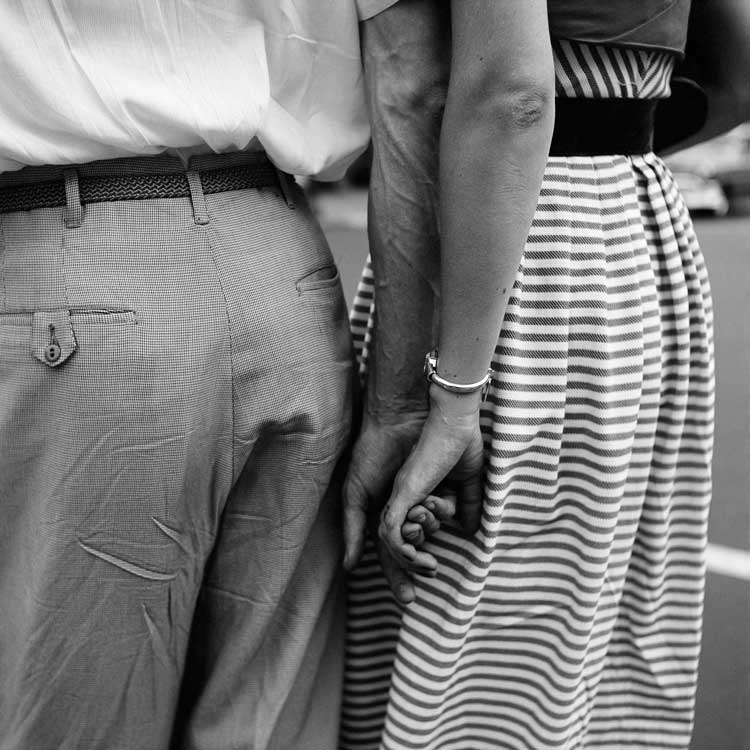
Vivian Maier, New York, July 27, 1954. © Estate of Vivian Maier, Courtesy of Maloof Collection and Howard Greenberg Gallery, NY.
There is glamour in some of the shots of women in their furs, against these bold, mid-century high-rise skylines. But they always look like real women, women who have lived and loved and worked. Previously, I had only seen the documentary, but much more of Maier’s life is revealed here. Where the documentary presented her as a nanny first and foremost, with a fantastic eye, here a timeline on one wall reveals that there was an origin story to her life as a photographer, and some ambition, too. When her father leaves them, she and her mother move to the Bronx to live with the photographer Jeanne Bertrand, and her mother acquires a Lumière Lumibox camera, before Maier acquired hers.
Maier clearly has ambition as a photographer before she begins nannying. She receives a small inheritance in 1950 and travels to France, where she learns how to develop film and make prints, then journeys further into Europe, to Spain, Italy and Switzerland. When she returns to New York in 1951, she plans to start a postcard business. But, perhaps struggling for funds, she takes her first nanny job. In 1952, she buys her first Rolleiflex camera, and uses the same darkroom facilities as two established female photographers, so she must have known that her gender didn’t have to be a handicap. From 1953 to 1955, she experiments with studio portraits and even creates a portfolio. She moves to California in 1955, and it is speculated that she hoped to break into the celebrity portrait market – the latter part of this show has some of her paparazzi and on-set snaps of stars such as Audrey Hepburn. But by 1956 she is back in Chicago, nannying.
The documentary reveals that Maier seemed socially awkward, perhaps more at ease with children than with adults. She was intensely shy and private. She ended up as a recluse (although it turns out she did not die destitute and friendless, but was looked after by three of her former charges, who paid for her lodgings until her death), and it is likely that her growing frustration and disappointment soured her character. There are stories in the documentary about maltreatment and neglect of the children in her care that these days would incur the wrath of social services.
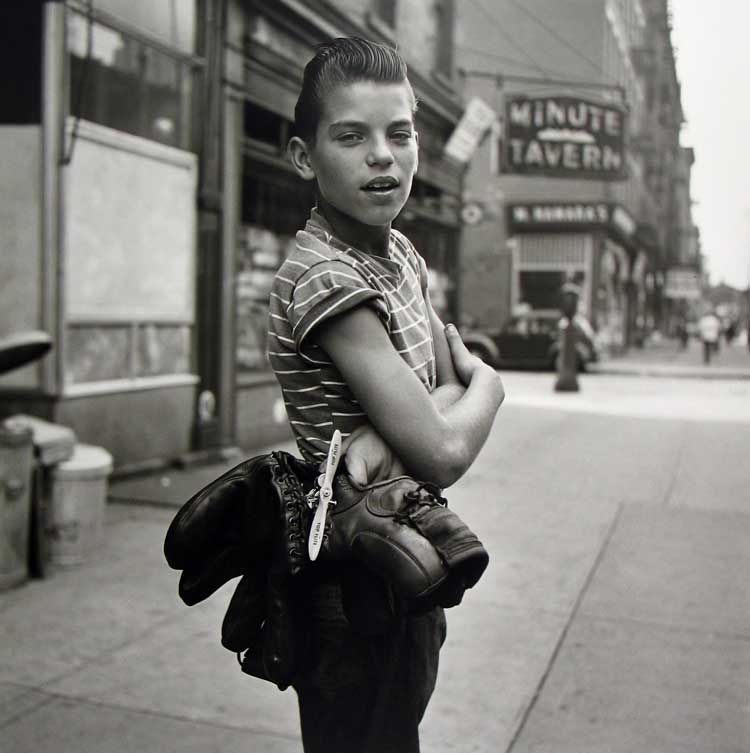
Vivian Maier, New York, September 3, 1954. © Estate of Vivian Maier, Courtesy of Maloof Collection and Howard Greenberg Gallery, NY.
This talented and overlooked woman and her work has made the reputation and to some extent fortune of Maloof, the man who discovered Maier, but he has also put in the hard graft, initially based on nothing more than a gut instinct that work this good should not go unrecognised. He invested in printing and showing her images, publicising, organising and curating exhibitions: there have been several in New York and Chicago, though this is the first exhibition in the UK. Tragically, he found his first photos two years before her death but did not discover where she was living until after she had died.
It is thanks to MK Gallery that we get to see the work. Anthony Spira, the MK Gallery’s director, says: “Vivian Maier’s story is an extraordinary one. The nanny who lived secretly as a world-class photographer whose remarkable work remained virtually unknown in her lifetime is now hailed as one of the greatest recorders of American life in the 20th century, cementing her place in the history of photography alongside Helen Levitt, Diane Arbus and Robert Frank.”
But we all know that this is not such an extraordinary story. In a cultural landscape only newly emerging from severely chauvinist and racist perspectives, we know there will be work by many more Maiers out there in the world’s storage depots, attics and basements. And that fact adds a bittersweet tang to this show, which does so much to reveal and celebrate “a life less ordinary”.
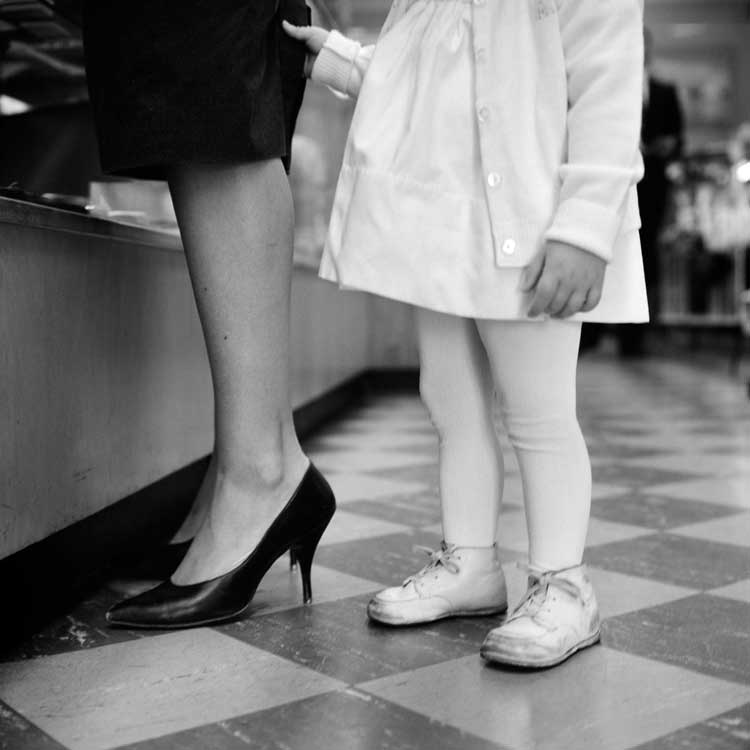
Vivian Maier, September 18, 1962. © Estate of Vivian Maier, Courtesy of Maloof Collection and Howard Greenberg Gallery, NY.